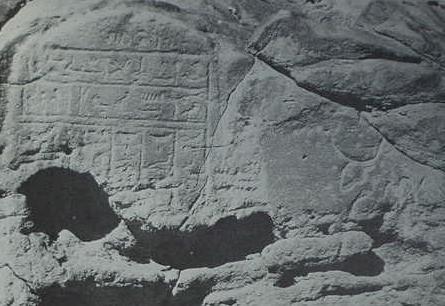Hieroglyphic inscription dating to the period of Pharaoh Amenemhet III (ca. 1929-1895 BCE, 12th Dynasty) on viewer's left, with an adjacent Proto-Sinaitic inscription to the viewer's right. This phenomenon led Sir Alan H. Gardiner to suggest that the Proto-Sinatic inscription was of the time period of Amenemhet III (cf. photo on p. 142. Raphael Giveon. The Stones of Sinai Speak. Tokyo. Gakuseisha. 1978)
Some scholars have suggested that the long-horned ox's head with accompaning ox-goad below the head (Hebrew eleph and lamed) is the Asiatic's name for their god, EL. If they are correct, perhaps the biblical imagery of the Hebrew God, called El, as a long-horned wild ox leading Israel in the Sinai, is recalling the Proto-Sinaitic images (Nu 24:8) ? That is, although there is no "image" God in the Sinai, he is iconographically represented in his very name as an Ox or Bull, recalling that the Ugaritic poetry speaks of EL as "Bull El."
Nu 24:8 RSV,
"God [EL] brings him out of Egypt; he has as it were the horns of the wild ox..."
